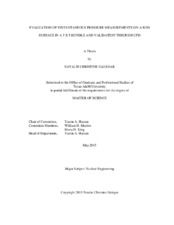| dc.description.abstract | Grid-To-Rod-Fretting (GTRF) in PWR fuel assemblies is a major issue of concern to vendors and utilities. Instantaneous pressure fluctuations on a fuel rod surface can help characterize the GTRF potential within a fuel bundle. As part of a collaboration with Westinghouse Electric Company, instantaneous pressure was collected experimentally at Texas A&M using pressure transducers installed within an instrumented rod. In addition, a Computational Fluid Dynamics (CFD) simulation was generated at the Westinghouse Fuel Fabrication Facility in Columbia, SC using a uniform velocity inlet condition. The simulation was repeated at Texas A&M with a non-uniform velocity inlet condition to determine the validity of the uniform inlet velocity assumption. The results from both simulations were used to compare with the experimental measurements.
Instantaneous pressure obtained from CFD agreed with the experimental data within 10%. The trend of the pressure evolution along the axial direction showed a maximum increase at 1.4 hydraulic diameters from the grid. Measurements and simulation results were compared at 5 different azimuthal orientations and 8 axial elevations. Further testing and more robust simulations will be needed to determine if the two results could agree with less than 10% difference.
Through this analysis, it was discovered that the non-uniform inlet velocity condition yields different results than the constant velocity condition. On average, both simulations produced the theoretically expected number of vortices per subchannel, however, more cross flow was observed in non-uniform velocity inlet simulation throughout the axial domain than the first simulation. In this study, the flow appears to retain memory of the inlet boundary condition well after the turbulent effects from the mixing vanes begin to dissipate. This implies that defining the inlet velocity properly is vital for this type of problem.
Additionally, velocity vectors from the two CFD simulations were reduced to the resolution of experimental PIV measurements. The purpose was to prove that reducing vector field resolution does not lose meaningful data. Through side-by-side comparison, it was determined that this process does not remove the pertinent flow structures and will provide a means to benchmark PIV results to CFD using the same resolution. | en |


